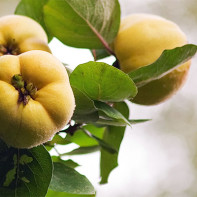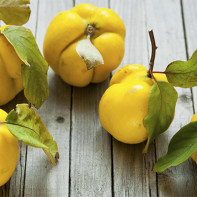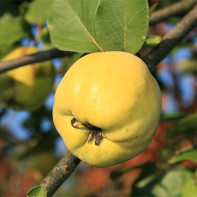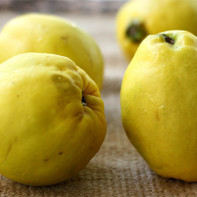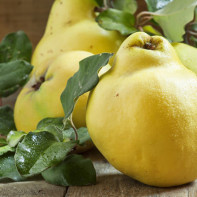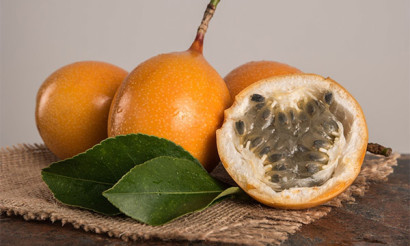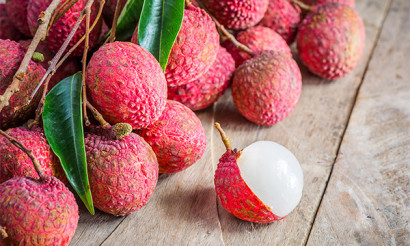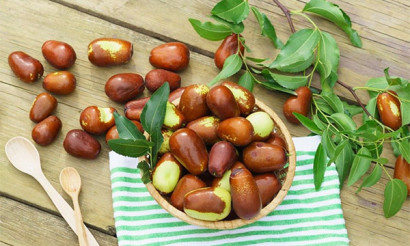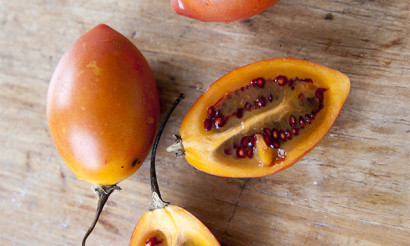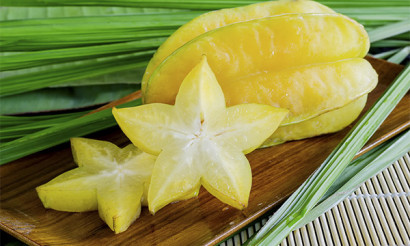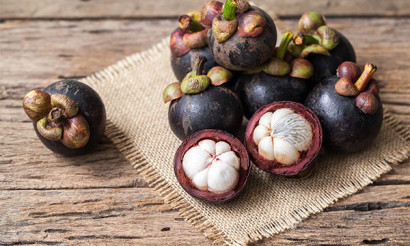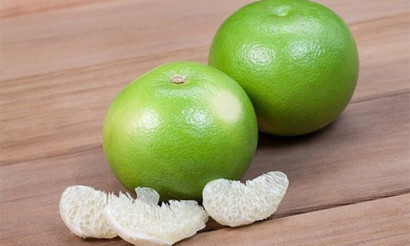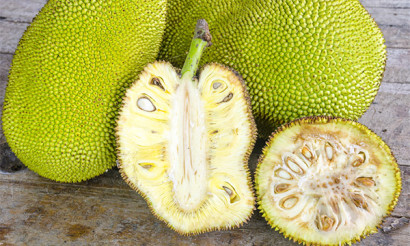Quince (fruit): useful properties and contraindications
Quince is a deciduous plant with beautiful flowers and edible fruits. The fruits have a soft tufted surface and a golden yellow color. There are three species of quince, which belong to different botanical genera: the common quince, the Japanese quince, and the Chinese quince.
- Composition and calories
- Common Quince
- Japanese quince
- Chinese quince
- Useful properties of quince
- General Utility
- For Women
- For Men
- In Pregnancy
- When breastfeeding
- For kids
- When losing weight
- What are the useful quince leaves
- Useful leaf tea
- Dried quince benefits
- Recipes of traditional medicine with quince
- Infusion of Seeds
- Infusion of fruit pulp
- Infusion of quince core
- Decoction of fruit pulp
- Quince syrup
- Vitamin-mineral syrup
- Quince tea
- Leaf Infusion
- Quince in cosmetology
- For Face
- For Hair
- Hazards and Contraindications
- How to Choose and Store Quince
- When to pick
- How to read ripeness
- Can it be frozen?
- How to dry
- What to make from quince: Recipes
- Jam
- Juice
- Juice
- Marmalade
- Candied
- Sauce
- Baked Quince
- Pickled Quince
- How to Eat Quince
- How much can be eaten in one day
- Can I Eat at Night
- Can ornamental quinces be eaten?
- Can we give quinces to pets?
- Interesting facts about quince
The common quince is the most common. It is a sprawling tree up to 4 m high, with large fruits. They are apple- or pear-shaped, weighing from 200 to 600 g, depending on the variety and location of cultivation. Their flavor is usually sweet, slightly astringent, with tart notes. Some varieties have smooth fruit, others have a delicate downy coating.
Japanese quince (Henomeles) is less well known but is highly popular among gardeners as an ornamental shrub up to 2 m high with very valuable but sour fruits.
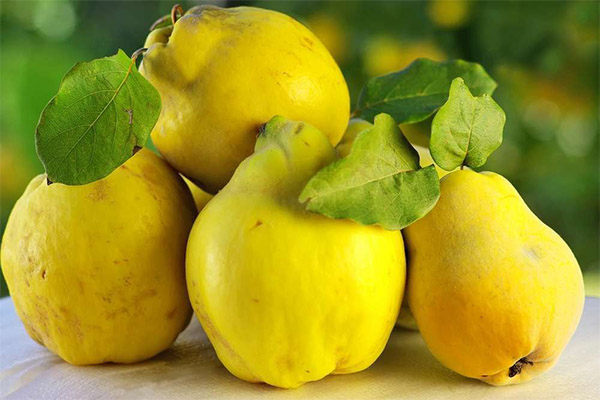
The Chinese quince is known mainly only to professional gardeners. It is not widely distributed and cultivated mainly in Indochina. This plant is a tall (up to 6 m) tree with delicate pink flowers and very large, hard, sour, astringent fruits. They sometimes weigh up to 2 kg.
Fruits are used only after heat treatment because of their tartness, although some varieties of Common Quince can be consumed fresh.
Composition and Calories
Common Quince
Mature quince contains organic acids, fructose, starch, dietary fiber, pectin, essential oil, tannins, polyphenols. The seeds contain fatty oil, mucus and amygdalin glycoside. This fruit can be considered dietary, as the caloric value of its fruit is 49-55 kcal per 100 g. The rest of the indicators:
- proteins - 0.4 g;
- carbohydrates - 9,6-15,3 g;
- fats - 0,1 g;
- ashes - 0,4 g;
- water - 83.8 g.
Set of trace elements in quince fruit is very diverse:
- potassium;
- magnesium;
- iron;
- phosphorus;
- calcium;
- selenium;
- copper;
- zinc;
- manganese.
The fruit is also rich in vitamins A, B1, B2, B3, B5, B6, B9, E, C, K, PP.
The useful substances in quince can easily fill the daily requirement of the body.
Japanese quince
Its energy value is slightly lower than that of the common quince and is 48 kcal. Per 100 grams of fruit are:
- carbohydrates 6 g;
- fats 0.1 g;
- proteins 0.4 g;
- ashes 0,4 g;
- water 83.8 g.
The composition of Japanese quince is similar to that of the common quince, but it contains a slightly smaller set of vitamins: B1, B2, B6, C, E, PP, carotene.
Macro- and micronutrients are represented by calcium, magnesium, manganese, nickel, boron, titanium and iron. This type of quince contains starch, fiber, saccharides, saturated fatty acids, pectin, phenolic compounds, essential oils.
The fruits of Japanese quince have found widespread use in folk medicine, but they have certain contraindications.
Chinese Quince
Chinese quince also has a low caloric value: 50 kcal per 100 g of fruit.
Its composition includes phosphorus, calcium, potassium, copper, as well as a very high percentage of iron. Complement the list of useful components of the Chinese quince vitamins A, C, E, group B, organic acids, pectin, dietary fiber, tannins, starch, mucus, saccharides.
This useful fruit has found use in folk medicine and cooking in Southeast Asia.
Useful properties of quince
General benefits
All types of quince have restorative properties. Under its influence, increases the body's defenses and stress resistance.
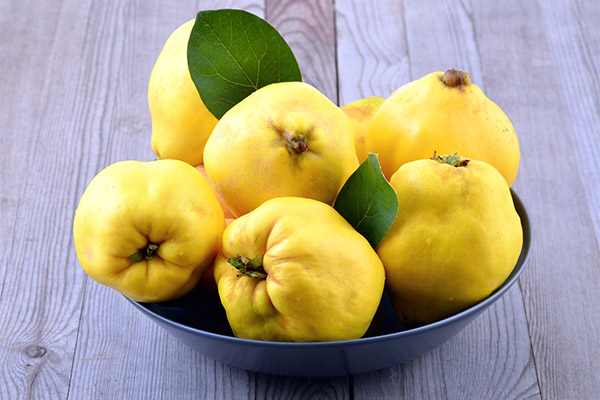
The fruits have a bactericidal and anti-inflammatory effect. When they are regularly taken with food inflammatory processes in the body are reduced, destroying pathogenic bacteria and viruses. Therefore, the use of quince is recommended during epidemics of acute respiratory infections and influenza. Quince also inhibits some parasites, stops intoxication when poisoning. In the mountainous regions of decoction and juice of fresh quince has long been used to treat diseases of the ear, throat, nose, eye inflammation. Fresh quince can be used as a mild antipyretic.
Dietary fiber absorbs excess water, cleanses the walls of the intestine, increasing its peristalsis. Normalizes the outflow of bile, lowers blood cholesterol levels. Puree of boiled fruit is prescribed for liver diseases, as well as an antiemetic. The tannins in the pulp help in the treatment of gastrointestinal disorders, stopping diarrhea.
The mucus of the seminal chambers, on the contrary, affects the intestines as a mild laxative, allowing the treatment of constipation. The enveloping property of the mucus has found wide application in the treatment of periodontal disease, colitis, gastric and duodenal ulcers. The mucilage infusion helps protect the digestive tract from the irritating effects of various medications. It has expectorant properties and is used in bronchitis to treat coughs. You can use it externally - to heal minor skin injuries and burns.
Fresh or steamed quince is used to stabilize the pancreas, respiratory and digestive systems, for the prevention of acute respiratory infections and cardiovascular diseases.
An important property of quince - the ability to reduce blood pressure. Fresh quince acts as a mild diuretic, which allows you to reduce the load on the kidneys, heart and blood vessels, reduce swelling.
Potassium together with vitamin C strengthens the body's defenses, and combined with calcium and pectin protects cells from toxins and radionuclides. The large amount of iron in the fruit helps fight anemia. Quince syrup is recommended to drink with anemia.
Polyphenols, which act as antioxidants, fight free radicals in the body, slowing its aging. It prevents the risk of stroke, heart disease and malignant tumors.
Decoction of pulp increases appetite, and decoction of seeds is used to stop hemoptysis. Cracks of the anus and hemorrhoids are successfully treated with hot compresses with quince juice. Fresh juice treats cracked nipples in nursing mothers.
Japanese quince, thanks to its large amount of iron and pectin, is used to cleanse the intestines of toxic substances. Its fruit lowers blood sugar. Vitamins help to restore strength in chronic fatigue and after a serious illness.
Chinese quince is famous for its very high level of ascorbic acid, iron and organic acids. Consumption of this fruit can regulate the activity of the brain and nervous system, reduce anxiety syndrome, improve sleep and memory.
For women
- The presence of antioxidants helps to cope with stress and strengthen the immune system, including during PMS, have a positive effect on the well-being and mood of women of all ages. Anxiety and irritability are reduced and overall tone is increased because the product is rich in phosphorus, calcium and potassium, which are involved in strengthening bone and muscle tissues, the nervous, respiratory and cardiovascular systems. This allows cells to function naturally, preserving beauty and health.
- Quince also helps those who want to find a slender figure. The fiber in its composition not only normalizes digestion, but also, by swelling, creates an additional feeling of fullness, distracting from overeating. Thus, women who regularly consume quince lose weight.
- Regular use of decoction of the pulp of the fruit helps with uterine bleeding, reduces their abundance and duration. During menopause, this amazing fruit will also provide substantial support, participating in the regulation of hematopoiesis and normalization of all organs and systems.
Women are strongly recommended to include quince in their diet. Very useful is tea brewed with pieces of quince, as well as puree or jam.
For men
- Vitamin A strengthens the walls of blood vessels, normalizes heart rate and stable blood circulation, is involved in the prevention of cancer.
- Vitamin PP is essential in protein metabolism, regulates the growth of muscle mass, slows the absorption of glucose, prevents thrombosis. This is especially important for heavy physical exertion and sports. A significant amount of iron in the fruit promotes hematopoiesis.
- Vitamin C is involved in the overall metabolic process, in the breakdown of fat cells, increasing stress resistance, has a positive effect on potency and libido. In ancient times, folk healers recommended quince to families that have problems with conception and childbirth, and not only for men but also for women.
- Decoction of quince seeds has an antiseptic effect on the skin, relieves irritation and inflammation. Therefore, since ancient times it has been used as an aftershave lotion.
In pregnancy
During pregnancy, quince is recommended for all women in the absence of individual intolerance. And this is not surprising: quince fruits have almost the entire complex of vitamins and trace elements, which must be replenished by the future mother, so that her baby could develop normally. Magnesium, calcium, potassium, phosphorus, iron - these and other trace elements are required in increased amounts, because it is from them that the new little body is formed.
Decoctions and purees from the fruit can be a real salvation at the initial stage of pregnancy - anti-vomiting effect of quince effectively helps with early toxicosis.
When breastfeeding
During lactation, despite all the benefits of quince, the new mother is better to temporarily give it up for the first three months. By that time, the baby's digestion will be relatively stabilized, and the mother will be able to include new foods in the menu without damage.
You should start with one spoonful of pureed boiled quinces. Be sure to watch the reaction of the child to the new food. If there will not be a tendency to constipation, and in daily digestion has not changed, you can continue to enter the quince in the diet on a regular basis, gradually increasing the dose. However, a nursing mother should not abuse the fruit - this can lead to constipation in both the child and herself. It is best to enjoy quince once every two weeks.
For kids
Introduce quince in the diet of the child can not earlier than 11-12 months, and only in boiled or stewed form. In this case, all the vitamins and minerals are preserved in full (except for vitamin C, which is destroyed by heat treatment). Quince is considered a low-allergenic product, however, it is necessary to carefully monitor the child's condition at the beginning of complementary feeding. At the first signs of allergy the fruit should be excluded.
Start complementary feeding with 0.5 teaspoon of puree, gradually increasing the amount of product at a time and bring it to 50 g per day.
You can mix quince puree with porridge or kefir, if a child does not eat a new dish. Give quince too often is not necessary, enough two or three times a week.
There is a quince in raw form baby can begin to eat at least a year and a half. By this time, the exotic fruit will not have on him such a pronounced reinforcing effect.
We must remember that quince need careful washing and sometimes cleaning. If lint from the surface of the fruit gets into the child's throat, it can cause hyperemia and dry cough.
For weight loss.
Quinces are low in glucose, especially Japanese and Chinese quinces. Because of this, the fruit has a low glycemic index: only 35 units. This allows people with high blood sugar, as well as those who want to lose extra pounds, to eat them without fear.
Quince is an excellent dietary product. A portion of baked quince can be a substitute for the main meal for lunch or dinner. You can have a "quince" unloading day. In between meals it is useful to drink a glass of decoction from the core of the fruit, which increases metabolism and promotes rapid cleansing of the intestines.
Dietary fiber absorbs and binds excess fluid, and then eliminates it from the body. The fruit has no fats and cholesterol, which would be deposited in the body "in reserve".
Quince leaves contain tartric acid, which is responsible for the processing of carbohydrates, so tea from the leaves is very useful for those who are struggling with excess weight.
What are the benefits of quince leaves
Quince leaves are just as useful as the fruit. They can be harvested from the time they appear on the branches until the leaves begin to fall, before the leaf laminae have lost their green color. Leaves are rich in potassium, phosphorus, calcium, iron. They contain vitamins C, E, P and group B (B1, B2, B5, B6), carotene, tannins, pectin, glucose and organic acids - citric, malic, tartaric.
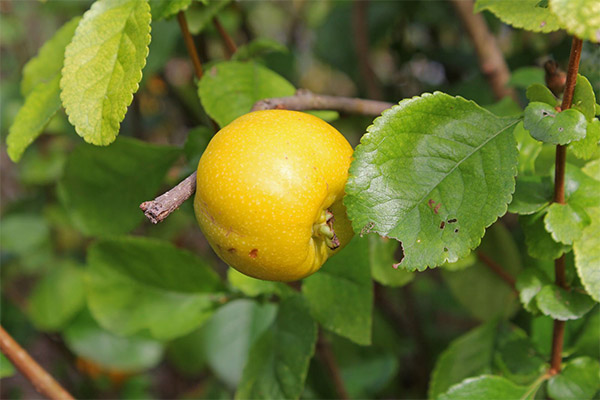
Use leaves as fresh and dried. Dried leaves can retain their useful properties for up to two years. Their powder can be added to various dishes, thus enriching them not only with vitamins and minerals, but also improving taste.
Infusion of quince leaves relieve attacks of bronchial asthma and cough in bronchitis, treat stomatitis and minor mouth inflammation. They are used as a gargle for sore throats. When taken orally, the infusion lowers blood sugar.
Crushed fresh leaves, decoctions and infusions have hemostatic properties and can be used for skin injuries and cuts, including deep ones.
Is Leaf Tea Useful?
Quince leaves also have many beneficial substances. They are often included in phyto teas and medicinal gatherings. Such gatherings help not only to saturate the body with essential micronutrients, but also to treat a number of diseases.
Tea helps with diseases of the liver, kidneys, urinary system, pancreas. It will be useful in disorders of digestion, flatulence, colitis, poisoning.
Quince tea helps with anemia, providing an alternative to synthetic iron preparations. It can be consumed by people of all ages, even children and pregnant women (under medical supervision). Regular use of such tea reduces blood pressure.
The benefits of dried quince
Dried quince fruits retain almost all the properties of the fresh ones. They can be consumed both in their natural crushed form and as compotes, decoctions or candied fruits.
The large amount of trace elements and vitamins in fruits allows you to keep the body in good shape all year round. Dried quince fruit can be used as fresh for the complex treatment of various diseases.
Quince is a part of dried compote mixes. Sometimes the dried quince is crushed and added as a seasoning to various dishes, including meat. Dried quince can be used for stewing, baking, as a filling for pies, previously soaked in water for a few hours.
Recipes for traditional medicine with quince
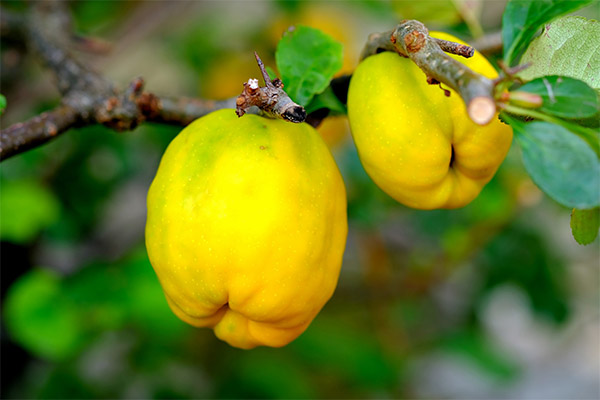
Infusion of seeds
It is important to remember: quince seeds contain a small amount of amygdalin glycoside, which breaks down to hydrocyanic acid in the intestine. Therefore, the seeds should be brewed only in whole, unbroken form and do not exceed the specified dosage.
10 g of whole quince seeds poured into a glass of boiling water. Insist 3-4 hours. Cooled infusion take 3 times a day by 1 tablespoon. It helps to cope with a dry cough and sore throat, colitis, and is also suitable as a soothing lotion for the face.
Infusion of fruit pulp
Finely chop a medium-sized quince and place it in 1 cup of boiling water. Infuse for 30-40 minutes until it cools. Take 1 tablespoon 3-4 times a day. The infusion is useful for angina, bronchitis, anemia, hypovitaminosis, hypertension. It can be drunk instead of tea, at once a whole glass.
Infusion of quince hearts.
Pour the core of 2-3 fruits with a glass of boiling water and insist 3-4 hours. The resulting mucilage solution take up to 4 times a day by 2 tablespoons. The remedy effectively restores abnormal bowel function and helps in getting rid of dysbacteriosis.
Fruit pulp decoction
2 quince fruits of medium size finely chopped and pour 750 ml boiling water, then bring to a boil. Boil for 10 minutes over low heat, then insist 2-3 hours under a lid until it cools. Take 0.5 cup once a day. This decoction will help to cope with swelling and indigestion.
Quince syrup
Cut 1 kg of fruit into slices and boil in 1 liter of boiling water for 15 minutes. Then remove the fruit, and add 0.5 kg of sugar to the broth, and then boil it until it slightly thickens. The syrup gives a tonic effect in the spring and winter. Take 3-4 times a day for 2-3 tablespoons, you can take with tea.
Vitamin and mineral syrup.
This syrup will be useful for anemia. Grate 2-3 quince fruits and boil until soft. Strain the decoction, squeeze the boiled quinces, add the juice to the broth. Continue to boil the syrup on low heat until it thickens. Take 1 teaspoon (due to high concentration) 3 times a day.
Tea with Quince
Pieces of quince can be added to a cup of tea instead of lemon. Quince, especially Japanese, will enrich the drink with a great taste and useful trace elements. Such tea is very useful for women in critical days, at menopause, as well as for stress, fatigue, anxiety.
Leaf infusion
1 tablespoon of crushed quince leaves pour 1 liter of boiling water and allow to infuse for 2-3 hours. Drink 2-3 tablespoons before meals. This infusion will relieve acute pain in the stomach and intestines, as well as relieve asthma attacks. Externally, the infusion is added to bath water to reduce sweating feet. It is also suitable for rinsing hair.
Quince in cosmetology
From the ripe fruit are obtained useful masks and lotions for skin of different types. Such products help to gently clean oily skin and narrow pores.
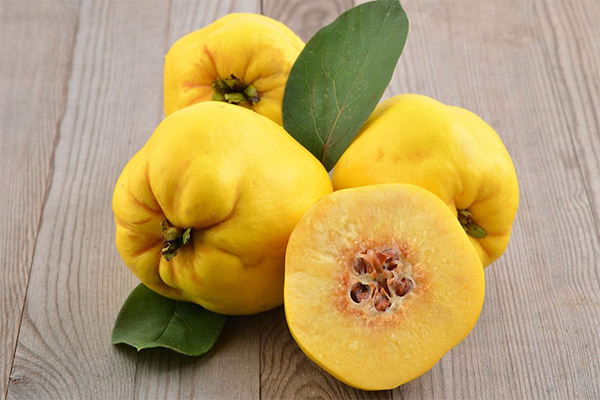
If you add various fats, egg yolks, starch to quince, you can get masks for dry and normal skin. They should be put on the face for 15-20 minutes, then rinse with warm water.
The juice of fresh quince is used to whiten freckles. Mucus from the seed chambers shows anti-inflammatory properties and allows you to treat minor inflammations and acne on the face.
The mucilage decoction also helps with scalp seborrhea and dandruff. And an infusion of leaves tones the skin and slightly dyes the hair, hiding graying.
For the face
- You can wipe a clean face with a fresh quince slice. This massage will, firstly, tone the skin, and secondly, saturate it with nutrients from quince juice. You can put on a face mask of finely grated fresh quince.
- For oily skin is suitable lotion made of quince. Pour the slices of fruit in lukewarm boiled water and infuse for 4-5 hours. Then drain the infusion and add 10 ml of vodka for every 100 grams of liquid. This lotion dries and tones the skin, it can replace the morning wash. A mask of finely grated quince and egg white mixed in equal parts has a good effect.
- For fading, flabby skin is perfect for a lotion made of equal parts fresh quince juice, alcohol and glycerin. You can make a lotion from the peels of the two fruits, infused for two weeks in a 20% alcohol solution, mixing the resulting infusion in equal parts with rose water. Effective mask of 1 tablespoon quince juice, one egg yolk and 1 tablespoon of olive oil.
- For dry skin is best suited mask of grated quince, egg yolk and cream mixed in equal parts. A mask of 1 teaspoon of honey, 1 tablespoon of butter, 1 tablespoon of grated quince and one egg yolk proved to be a good idea.
For Hair
Regular inclusion of quince in the diet helps to make the hair noticeably healthier. We remember that fruits contain iron, zinc and copper, which are involved in the processes of hematopoiesis. By increasing the production of red blood cells, the body enriches the hair follicles with nutrients and oxygen. Hair becomes stronger, firmer and shinier.
- To get rid of dandruff and seborrhea, pour warm water over the core of 3-4 quince fruits, bring to a boil over low heat and cool. The resulting mucilage infusion apply to oily hair and scalp, leave until completely dry, then rinse with warm water.
- Infusion of leaves allows you to tone the scalp and keep hair healthy and clean for a long time. In addition, quince leaf infusion is able to gently dye gray and blond hair into darker tones. The stronger the concentration of the infusion, the more intense will be the coloring of the locals.
Harms and contraindications
- Individual intolerance is the main contraindication. Sometimes in some people (although very rarely) quince can provoke an allergic reaction. In these cases, you should refuse to use the fruit.
- Under the ban quince is also in people suffering from pleurisy, enterocolitis, chronic constipation.
- With caution should be eaten sunny fruit those who have inflammatory processes or ulcers of the digestive tract, as well as a high rate of blood clotting. With particular care should eat quince during lactation.
- Fresh fruit can sometimes cause irritation of the larynx, coughing, and throat fart, especially if the covering fluff gets into the esophagus. This is especially characteristic of Japanese quinces. The astringent components can reduce the performance of the vocal cords, so quince should not be eaten before public speaking.
- Quince seeds should not be eaten. As with all rosaceous plants, its seeds contain amygdalin cyanide, which in the intestine breaks down into hydrocyanic acid and can cause poisoning. For the same reason you should not crush and knead quince pips before making infusions and decoctions.
How to pick and store quinces
Quince is one of the latest fruits and doesn't appear on the shelves until late fall and winter.

Its fruits are very delicate and do not tolerate any damage. Even a simple blow will cause quince to spoil almost immediately and will quickly go bad. Therefore, it is best to transport and store the fruit in individual containers, for example, wrapping each one in a layer of paper or plastic.
Quinces are best preserved at temperatures between 0 and 1 °C. A bottom drawer in the fridge or a cool pantry is good for this.
Quinces are said to be good neighbors in storage with apples. But keep it away from pears, as they speed up the ripening of quinces.
When to harvest
Early varieties begin to ripen by early September and can be eaten immediately. Late varieties are harvested in October. In Central Asia, where warm days last much longer, quinces are harvested in November.
The main rule of quince picking is to let them stay on the branches as long as possible. When the fruit starts to break off and fall off, it's harvest time. But what to do if frosts come and the late quince still sits firmly on the branches and also has green spots on the sides? Unequivocally, collect.
Such fruits, which have only reached technical maturity, will still lie in a dark cool place from 20 to 40 days before full maturity.
How to determine the ripeness
When choosing fruits, you should be guided by the following three criteria:
- Color. Fully ripe fruits have a bright golden yellow color. If there are pale, and even more so greenish spots on the skin, this indicates immaturity.
- Density. Even ripe quince is usually dense enough. But it should not have the density of a marble. In the hands should feel a lively elastic fruit, this will be an indication of its ripeness.
- Aroma. Ripe quince emits incomparable delicate smell. But if the fruit is not yet ripe, it will not smell.
Most importantly - the surface of the fruit should not have any damage or traces of impact, then it can be stored for quite a long time.
Can I Freeze?
Quince is excellent for freezing. After defrosting, it retains all of its useful qualities.
To freeze quince, it should be thoroughly washed, cleaned of the covering villi, divided into quarters and cut out the core. Next, cut the fruit into slices or cubes, put it in a cellophane bag and place it in the freezer. You can put sliced quinces on a board or a large dish in a single layer and freeze them, and then put them in a bag in the frozen form and place them in the cold.
You can defrost quinces in the air at room temperature or in the microwave.
Drying
Quinces can be dried in a drying oven or oven. You can also use a microwave or an aerogrill. Sun drying is generally not recommended because of its late maturity. You can air-dry it in a warm room or on a balcony by spreading the fruit slices out in a single layer.
Quince has a very dense flesh and if you dry it in the usual way, such as apples or pears, for example, without pre-treatment, the dried slices will be very brittle and almost tasteless. The quince, dried in this way, is suitable for making compotes or unsweetened dishes.
To get a better quality dry product, quince slices are first boiled in a weak sugar syrup or blanched. After that, they are placed in a colander to let the excess syrup run off, and then spread in a single layer in a well-ventilated room or on sheets in the oven. The real treat of dried quince is amber candied quinces.
What you can make from quince: recipes
Jam
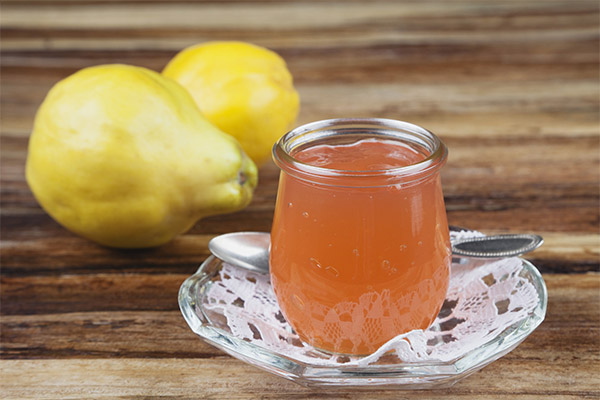
Products needed:
- 1 kg of quinces without core;
- 1 kg of sugar;
- 0.5 liters of water (for each additional kg of quince add 250 ml of water).
Optional: 100g walnuts, 1 teaspoon of citric acid (or 1 lemon), vanillin.
Rinse quinces, peel from the covering fluff, free from the core and cut into equal small pieces.
Make syrup with water and sugar. Put quince pieces in the boiling syrup and cook for 15-20 minutes. Add citric acid or sliced lemon. Then simmer on a low heat until tender. Readiness is determined by a drop of syrup, which should not spill on the plate.
Juice
Quince juice can be prepared in two ways: cold and hot.
In the cold method, wash and cleaned of fluff quinces finely grate and squeeze the juice by pressing.
At the hot method prepared pieces of quince pour a little water and steamed until soft. Steamed fruit strain through a sieve or gauze, along with the broth. We get juice with pulp. The remaining cake can be used for jam or marshmallow.
Pressed juice can be consumed as fresh or canned.
Compote
In a compote quince can act as a "solo" or in combination with other fruits.
For 3.5 liters of water will require:
- 1 kg of quince;
- 1.5 cups of sugar;
- 0.5 teaspoon of citric acid or half a lemon.
Boil the water, dissolve the sugar in it and add the quinces (together with other fruits, if desired). Cook for 15-20 minutes, then add citric acid or lemon juice. You can put the squeezed lemon and lemon zest into the compote before the end of cooking (you will need to take it out afterwards, so that it does not make the syrup bitter). Boil for another 5 minutes, then remove the pot from the heat and cool. You can drink the compote as warm or chilled.
You can preserve it for the winter. To do this, the hot compote should be distributed in sterilized jars and seal. Then put on the lids and cover until it cools.
Marmalade
Quince contains pectin, which allows you to prepare from it an excellent marmalade. Need the following products:
- 1.3 kg of sugar;
- 1.5 kg quince;
- 1 medium lemon.
For 20 minutes after boiling, boil the cores of quinces, pouring them with water just below the surface, then cool. When boiling, some of the liquid will evaporate and a jelly-like broth will remain.
Cut quinces and pitted lemons into small slices, put them in a saucepan and fill with water. Under a lid bring to a boil. Boil for 20-30 minutes over medium heat, then drain the broth. It can be used for compote.
Whip the quince pulp and lemon with a blender to a smooth puree (quince should be soft), then rub the puree through a sieve. Add the decoction from the core of the fruit and whisk again, then pour in the sugar and stir.
Bring it slowly to the boil, stirring continuously with a wooden spatula. When the mixture begins to boil, put the pan into a hot oven (180-200°C). Then steam the marmalade for 3-4 hours, stirring every 10 minutes. Marmalade will decrease in volume by a third or even half and begin to separate easily from the walls of the dishes.
Spread ready marmalade into moulds or spread it on an oiled tray and let it dry. This process may take several hours to a week, depending on the type of quince and the degree of boiling. Dried marmalade take out of the forms or cut, then sprinkle with powdered sugar.
Sucats
Ingredients:
- 1 kg sugar;
- 1 kg of quinces;
- 1 g of citric acid or ½ of a lemon;
- 0.5 liters of water;
- powdered sugar.
Peel quarters of quinces from the core and skin, leave, pouring cold water. Put peels and core into boiling water and boil for 20 minutes. Take the peels out of the broth, then boil quarters of quince in it for 20 minutes. Then take out quinces, let cool a little and cut into small equal slices.
In the broth dissolve half of the sugar. Put the quince slices into the boiling syrup and cook for 5 minutes. Then remove from heat and let stand for 5 hours to 24 hours. Then add the rest of the sugar, bring to a boil and boil again for 5 minutes. Again allow to stand for 5 hours to 24 hours. Repeat this procedure at least four times. Pieces of quince will get a golden orange color. Add citric acid or lemon juice to the syrup during the last boil.
Take the quince pieces out of the syrup on a sieve to drain the liquid, then transfer them to a plate and dry them for several days in a dry, warm room, turning them for even drying. Just before finishing drying, roll the candied fruit in powdered sugar and finish drying. Store in a dry glass jar under a lid.
The remaining syrup can be preserved for the winter or used to make morsels.
Sauce
Products:
- 1 cup water;
- 3 large quinces;
- 1 teaspoon lemon juice;
- 0.5 teaspoon coriander;
- 1 teaspoon paprika;
- 1/3 teaspoon ground black pepper;
- 1 bay leaf.
Wash and peel the quince, remove the pith, and remove the core. Slice, place in a saucepan, add water, lemon juice and bay leaf. Stew over medium heat for 25-30 minutes, then remove the bay leaf. Without draining the liquid, whip quinces with a blender into a puree, add all the spices, again bring to a boil, and then cool. This sauce is served with meat dishes.
The sauce can be prepared for future use and frozen in small molds. You can add to the above ingredients 1.5 tablespoons of 9% vinegar and roll the sauce for the winter in sterilized jars.
Baked quince
You can bake quinces in different ways: as a whole fruit, halves, rings, slices. You can add different toppings: honey, sugar, berries, nuts, raisins, cinnamon, ginger, cottage cheese, butter. If you have high blood sugar, you can bake quinces without additives or with a sweetener.
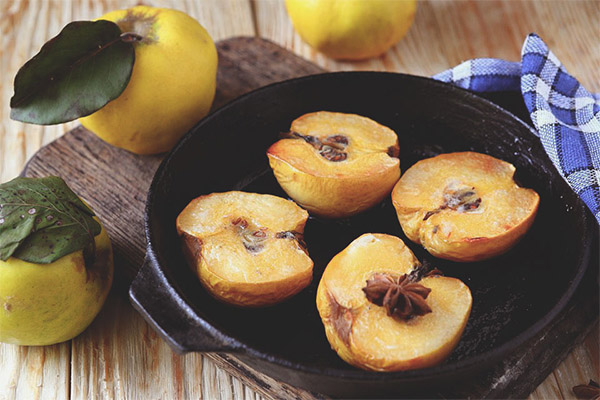
If honey is used as a sweetener, it is better to bake the quince as a whole fruit, covering it with a "lid" and removing the core, so that it does not overheat too much. When heated strongly, honey loses its useful properties and acquires harmful ones. You can, for example, mix honey with nuts, berries or raisins, fill the cavity in the whole quince with this filling and cover with a "lid". If the fruit is baked in pieces, it is better to use sugar. Quince halves are very tasty if before baking they are smeared with butter and sprinkled with sugar.
Bake quinces at 180-200 ° C. If you use baking foil, the dish will be more juicy. Serve the baked dessert both hot and cold.
Pickled Quince.
Products:
- 1 l of water;
- 1 kg of quince;
- 200 grams of sugar;
- 6-7 clove buds;
- 1 teaspoon cinnamon;
- 100 ml of 9% vinegar.
You can add salt, garlic, hot or ground black pepper to the marinade. Then the taste of pickled quinces will be more spicy and tangy.
Bring water to a boil, immerse peeled and sliced quince in it, cook for 8-10 minutes. In sterilized jars put spices and top with quince slices. Add sugar (optionally - salt) to the quince broth, bring to a boil and pour the vinegar. Pour the boiling marinade into jars, seal and place under a warm cover until cool. Pickled quince will be a great addition to meat and vegetable dishes.
How to eat quince correctly
Raw quince is not to everyone's taste because of its tartness and hardness. But there are not very tart and even sweet varieties that can be eaten fresh. In addition, they have almost no covering fluff on them. If the quince is heavily pubescent, it should not only be thoroughly washed before consumption, but also peeled. Fresh quinces are best eaten sliced into small slices.
You can drink fresh juice squeezed from quince. It is useful for iron deficiency anemia. If quince is too tart and astringent, you can pre-clean and steam the fruit and make a juice with pulp.
Very tasty quince puree of softly boiled and pureed fruit. You can grind them in a blender, make marmalade, jelly, compote, jam, bake the fruit in the oven.
Quince is an excellent seasoning for meat dishes. It is used for making sauces and gravy, and stewed together with meat. Pilaf with quince, which is added just before putting the rice, turns out amazingly tasty.
When heated quince loses its astringency, its taste becomes softer and sweeter.
How much can be eaten in a day
There is no limit on the amount of quince eaten per day. It is worth remembering only that the absorption of the fruit in large quantities can lead to constipation. Therefore, it is better to eat no more than 2-3 fruits a day.
Can I eat at night?
At night it is better not to eat anything at all. Take food, and including quince, should be no later than three hours before bedtime. However, there are no bans on eating quince for dinner. On the contrary, this fruit will bring a lot of benefits if you include it in your evening diet. During sleep, under the influence of quince components, hematopoiesis is enhanced, hemoglobin levels increase, and blood vessels are purified. Mild diuretic properties allow you to flush out of the body of toxins and toxins.
Is it possible to eat ornamental quince
Decorative quince usually refers to Henomeles - Japanese quince, the fruits of which are not only edible but also very useful. Unlike the common quince, which can sometimes be eaten raw, the fruits of Henomeles in fresh form are very dense, tart, sour, astringent to the mouth and throat. However, after heat treatment, especially with the addition of sugar, honey and spices, their taste improves markedly.
Can we give quinces to pets?
Quince fruits and leaves are a valuable source of minerals and vitamins. Therefore, they can be added to the food for farm animals and even for dogs and cats, but only in minimal quantities. An overdose can cause allergic reactions and vomiting. It is best to put dried powder from the fruit or leaves in the feed.
Interesting facts about quince

- Quince has been known to people since time immemorial. Its homeland is considered the Caucasus. However, it was also widespread in the Mediterranean. With seaside inhabitants it symbolized fertility, love and marriage. The fruit was even served on royal tables as a sign of greatness.
- With the ancient Greeks quince was revered as sacred. The fruit was used to refresh a bride's breath before entering the marriage tent. Quince trees were spread in homes to give them freshness and warmth. The famous "apple of discord" which divided the three Greek goddesses Hera, Aphrodite and Athena was, according to legend, not an apple at all, but the golden quince fruit. The golden "apples of Hesperides" were, undoubtedly, quinces as well, since the ancient world did not yet know apples. There is a hypothesis that the quince was also the fruit from the tree of knowledge of good and evil, with which Eve seduced Adam. Images of quince have been found in mosaic frescoes among the ruins of Pompeii.
- The quince tree likes a warm, humid climate, but is tolerant of both prolonged droughts and floods, and lives and bears fruit for up to 50 years. Wild varieties are more hardy but produce fewer fruits, inferior in taste and size to breeder varieties. Today there are varieties released for more northern conditions and have a better taste and appearance of fruits.
- Quince seedlings are used as rootstock for pear twigs.
- Quince grown in Central Asia is considered the most delicious. Quince is considered the most common fruit in Turkey.
- Quince makes an excellent marmalade. The term marmalade itself originates from the Portuguese "marmelo" and means quince. Also made of the golden fruit are candies, marshmallows, jams, jams, used in wine-making and as a seasoning for meat.
- In decorative floriculture, quince is considered one of the best plants for creating bonsai. In horticulture, Japanese quince is used to create hedges. The hedge is always graceful: in spring it is studded with red or pink flowers, and in autumn - with small bright yellow fruits with a sour astringent taste and a slight lemon flavor.
«Important: All information on this site is provided for informational purposes only for informational purposes only. Consult a health care professional before taking any recommendations. health care professionals before using any of the recommendations. Neither the editors nor the authors shall be liable for any possible harm caused by materials."

